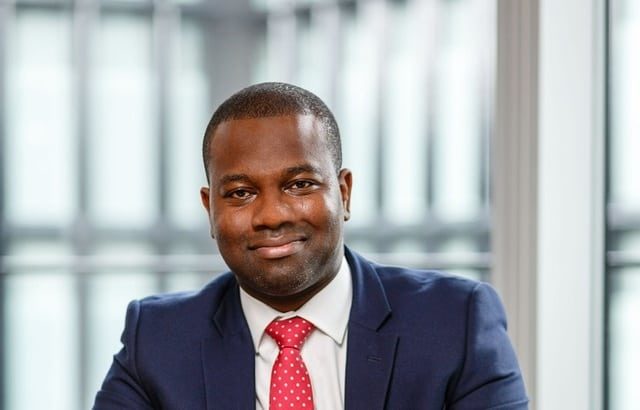Often in the long-running debate that fills news pages across financial services you could be forgiven for believing that the opposing supporters of active and passive investing are mortal enemies, unable to see eye-to-eye on the so-called ‘best approach’ to investments.
Well, at the polished offices of LGIM, the European asset management behemoth with £957bn in assets, you will find a self-proclaimed man in the middle.
Justin Onuekwusi, lead manager of LGIM’s multi-index fund range, balances running a strategy heavily reliant on index-trackers, with a belief in the benefits of actively managed funds.
The argument between the two sides has become too heavily focused on the type of allocation in certain regions or sectors, Onuekwusi says.
“The debate seems to be all around whether your UK equity position is active or passive or if your US position is active or passive, but that is not the key driver of risk. The key driver of risk is how much you have in the UK or the US, the asset allocation,” he says.
Active Vs Passive
Instead, Onuekwusi believes in managing the asset allocation actively in order to be able to manage risk and meet advisers’ need for suitability as well as opening up opportunities in different spaces.
He adds: “In the five years to the end of 2015, the average US equity manager returned 80% and the average emerging markets equity manager did -20%, so you could have picked the best manager in the emerging market space and they would have underperformed the worst manager in the US equity space. The key decision is what space you’re in.”
Up to 25% of the LGIM index growth funds, and up to 30% of the income funds, can be allocated to active strategies. These aren’t tunnel vision index funds for the passive preachers parading amongst us.
“We’re not index for the sake of it and we can go active, I’m actually a big believer in using active management for individual building blocs when necessary,” Onuekwusi explains.
He adds: “Ultimately the decision on whether you go index or whether you invest in a fund of passive funds or active funds, comes down to the end investor. What do they want? Do they want something that is cost effective or do they want to pay for the potential of alpha?
“What I’ve found over time is that due to a lack of confidence investors are moving towards cost effective solutions.”
It is this emphasis on cost that shines through Onuekwusi and his approach to fund management, believing as he does in the power of scale to lower costs and improve returns.
It’s a belief that lines up with the regulator’s current approach to fund management and its criticism of high fees and charges. It is a concern that is coming increasingly to the fore Onuekwusi says.
Along with the ability to build a multi-index strategy from scratch, the ability to join a larger firm where costs can be managed was a key reason behind his move from Aviva to LGIM back in 2013.
“There is a move towards cost-effective solutions both in retail and institutional. Retail with post-RDR and institutional as you move from DB to DC and, for me, I fundamentally believe that costs are the only thing that are guaranteed to detract from returns in fund management.
“So, people can talk about how great they are at managing money but costs are the only thing that you are 100% guaranteed will detract from returns year, after year, after year, so it’s so important to try and manage them.”
Having the scale in index funds to build “cost effective solutions” is something that is unique to LGIM, Onuekwusi says.
“In terms of a multi-asset solution we do think we’ve got probably the most cost effective in the market, not necessarily the cheapest, just cost effective in that we’re actually quite active within the strategy in moving across different index funds.”
The range of multi-index funds, which invest primarily in Legal and General index tracker funds, have been popular with clients and have grown to near £1.38bn in assets across five strategies. An impressive story given the funds only launched four years ago.
Each of the strategies starts from a single point, a single diversified portfolio which is then adjusted based on the teams’ views over how the asset classes and global economy will perform over, typically, a five-to-10 year time horizon.
Among the views shaping Onuekwusi’s allocation at the moment is a belief that the US Federal Reserve will lead the way by increasing interest rates, with the dollar to strengthen over the medium term despite “some deviations along the way”.
“We think that we’re approaching late cycle and although we haven’t seen a pick up in inflation more recently we do think over medium term, given the labour market is tight and given all the talk of reducing immigration, that something has to give and eventually wages will start to rise. When wages start to rise you will see a creep up in inflation and the central banks will let themselves get behind the curve to actually generate that inflation,” he explains.
Taking this into account, Onuekwusi has a bias towards inflation-sensitive assets and US Treasury Inflation Protected Securities (TIPS).
Other areas getting the thumbs up, for now, include US commercial property, accessed via the actively managed LGIM Property Fund, and India, one of the only emerging markets favoured by Onuekwusi’s team.
However he has no exposure to UK index-linked gilts, as he says not only does the duration completely overwhelm the inflation protection, “but also because we think inflation in the UK is transitory and essentially has been driven by this fall in sterling”.
He also currently has no exposure to China. “We think China will see a slowdown, they have borrowed significantly,” he says.
“Every lesson in history tells us you can’t continue to borrow like that without eventually seeing some sort of financial crisis or stuttering in growth, so China will eventually have to de-lever and so you will see that stuttering of growth. The difficulty is finding out when it’s going to happen and the magnitude of that stuttering.”
China is one of the three key risks that could derail the current long-running bull market Onuekwusi believes, as well as unexpected moves from central banks or risks in the new “political paradigm”.
“I would say we are relatively cautious,” he adds.
Onuekwusi is keen to stress that stances such as “relatively cautious” are the result of a whole team, about 25 people in fact, building up research, analysis and management ideas.
As lead fund manager, he has the economists to help set the macro stage, strategists who work out how macro events will impact different asset classes, and the fund managers who then create portfolios that “make sense” after being handed the collected information.
Key to creating each strategy, as touched upon earlier, is the risk targeted nature of each of the funds.
Being risk targeted is key and Onuekwusi speaks proudly of being one of the first funds to join the Investment Association’s recently launched Volatility Managed sector.
“There was a huge issue in the market where advisers could not differentiate between a risk-targeted fund and a risk-rated fund. So, by going into the volatility targeted sector it means we are saying we are committed to targeting our risk profiles and we want to be identified as risk-targeted rather than a manager that is just risk-rated and can drift over different profiles over time,” he explains.
It was fundamental to the decision to join the sector that the LGIM funds be viewed as risk-targeted.
“I think it’s important to know the primary objective of these funds,” Onuekwusi adds.
“It isn’t necessarily to be top quartile or the best performer in a particular sector, it’s just saying we are targeting this risk profile and we’re going to deliver strong returns within that risk profile. Before it we were in the mixed investment sector and that wasn’t really the objective.
“I think it has helped investors find the funds and understand the difference between risk targeting and rated.”
The arrival of the new sector marked an understanding that the type of products available had changed drastically and a sign of how ideas and products across the investment universe have evolved.
“If you looked around 20 years ago there was effectively UK equities, overseas equities, bonds and overseas bonds and cash. As time has gone on we’ve moved from a more peer-group multi asset environment to one that is more focused on outcomes, either targeting level of risk or level of return.
“It will continue to evolve, now we have infrastructure, there is emerging market debt, Australian government bonds.
“Within index funds, the most cost-effective space, managers are going to continue innovating and developing different types of index funds, which is going to allow access to asset classes at a cost effective rate.”
One of the biggest jumps forward has been the rise of ‘factor-based investing’, otherwise known as smart beta, which Onuekwusi believes will only get bigger and will soon be available widely on the retail market.
We should expect them to come into the retail space to shake things up, throwing extra coal onto the passive and tracker fire and upping the variability that Onuekwusi loves about his job in fund management.
He says: “Since I’ve moved into fund management it’s been something I’ve really enjoyed, the variability is good you can research you can build portfolios and go and see clients, so in terms of job satisfaction you definitely get that. I think I’ve found my passion.”







